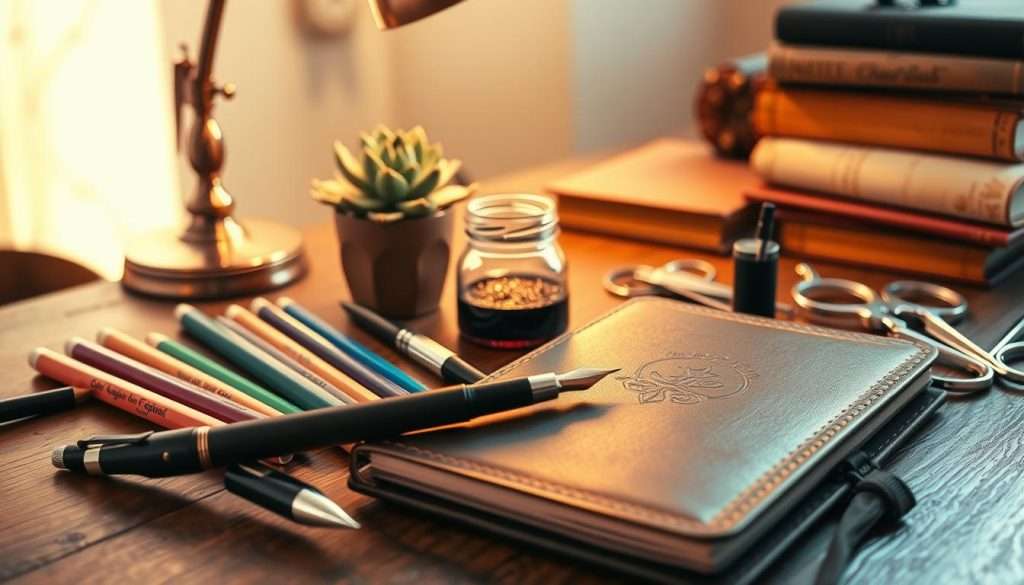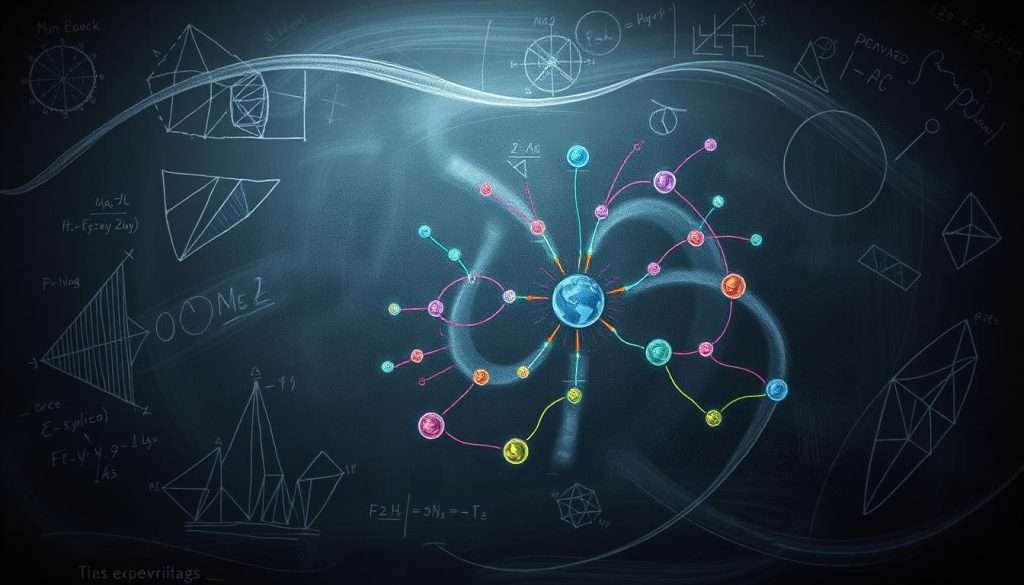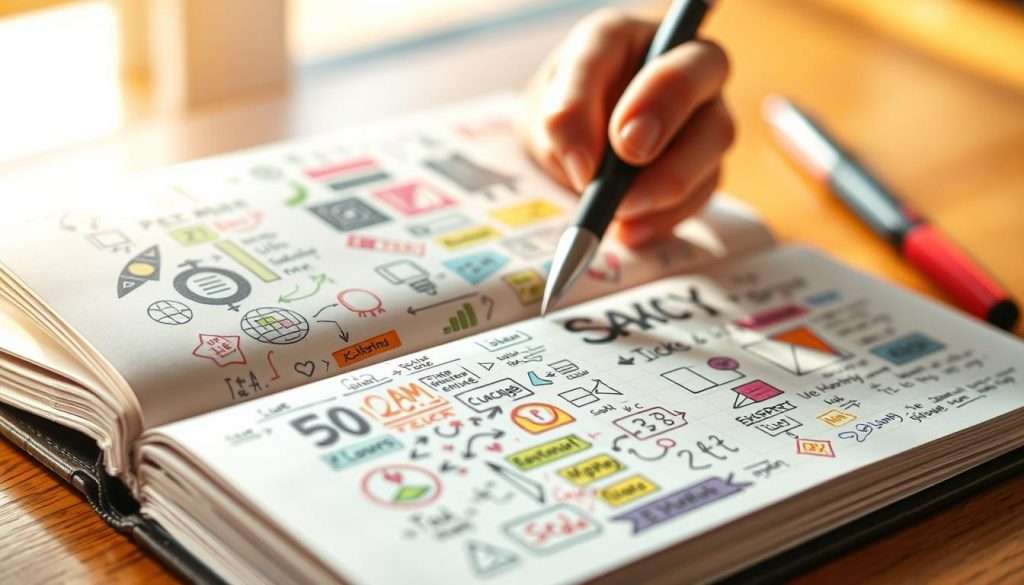Are you tired of studying the same old way, only to forget what you’ve learned? It’s time to mix things up! By adding creativity to your notes, you can remember things better and understand complex ideas.
Imagine being able to remember information more easily, just by making your notes more fun and visual. This is what artful note-taking is all about. It’s a way to use art and writing together to help you learn better.
By using creative learning strategies, you can make studying fun and useful. Whether you’re in school or always learning new things, adding art to your notes can really help. It makes a big difference in how well you learn and remember.
Key Takeaways
- Boost retention by making notes more engaging and visual.
- Combine art and writing for more effective learning.
- Transform study sessions into an enjoyable experience.
- Improve recall by using creative note-taking techniques.
- Make learning more effective with artful notes.
The Power of Visual Learning
Visual learning is a powerful tool that changes how we learn. Our brains are better at handling pictures than words. This makes visual learning great for students and anyone who wants to learn more.
How Our Brains Process Visual Information
Studies show our brains handle pictures differently than text. Visual data is absorbed quickly and stays longer in our minds. Sunni Brown says in her TED Talk, “The doodle revolution is about embracing the power of visual thinking.”
The Connection Between Art and Memory
Art and memory are closely linked. Creating artful notes helps us remember better. Leonardo da Vinci’s doodles show how art can improve memory and understanding.
Visual Learning vs. Traditional Note-Taking
Traditional note-taking has its uses, but visual learning is more engaging and effective. Adding pictures to our notes helps us remember and recall better. This makes learning more fun and efficient.
By using visual learning, we can make our study habits better. It also improves our learning experience.
The Da Vinci Method: Study Smarter with Artful Notes
Leonardo da Vinci’s way of learning through artful notes is still useful today. He mixed art and science in his notes. This helped him learn better and come up with new ideas.
Leonardo’s Unique Note-Taking Approach
Da Vinci’s notebooks are famous for their mix of sketches, diagrams, and text. This integration of visual and textual information helped him think creatively and critically. For example, his drawing, the Vitruvian Man, shows how he combined art and science.
Key Elements of Da Vinci’s Visual Thinking
Da Vinci’s visual thinking had a few key parts:
- Observation: He carefully watched the world and recorded what he saw.
- Curiosity: He always asked questions and looked for answers through experiments and research.
- Interconnectedness: He saw links between different ideas and concepts.
Together, these parts made a strong way to learn and solve problems.
Why Da Vinci’s Methods Still Work Today
Da Vinci’s methods are still good today because they use the brain’s love for pictures. By adding doodles and sketches to our notes, we can remember things better. This way of learning makes it easier to understand and remember complex stuff.
In short, the Da Vinci method is a great way to study smarter with artful notes. By using this timeless method, learners can reach their full potential and do well in school.
The Science Behind Doodling for Learning
Doodling taps into many brain areas, helping us understand and remember better. It’s not just simple drawings; it’s a way to boost our learning.
Research on Doodling and Cognitive Retention
Studies show doodling can help us remember more. A study in Applied Cognitive Psychology found doodlers remembered more than non-doodlers. This proves doodling is a great creative learning strategy.
How Artful Notes Engage Multiple Brain Regions
Doodling uses both sides of the brain. The left side handles words and logic, while the right side deals with pictures and space. This mix makes learning more effective, using effective study habits and visual learning methods.
Debunking the “Doodling Means Distraction” Myth
Some think doodling is a distraction. But research says it keeps us focused. It uses our visual and motor skills, stopping our minds from wandering.
In short, doodling is scientifically proven to improve learning. It boosts retention, engages the brain, and is a valuable tool in education. Adding doodling to our study habits can make learning better.
Essential Tools for Artful Note-Taking
To start with artful note-taking, you need the right tools. You don’t have to spend a lot or buy fancy stuff. There are many options for everyone, whether you like traditional or digital tools.
Basic Supplies to Get Started
For those who like to write by hand, you’ll need notebooks, pens, markers, and colored pencils. Choose a notebook with good paper for different pens and pencils. Markers or colored pencils can make your notes look great.
Digital Options for Artistic Note-Taking
If you prefer digital tools, there are many apps and software for artistic note-taking. Effie’s mind mapping feature is a great digital tool for visual notes. Other apps let you draw in your notes.
Creating Your Personalized Artful Note-Taking Kit
Experimenting with different tools is key to finding what works for you. Try mixing traditional and digital tools in your kit. Here’s a simple comparison of some popular tools:
| Tool | Traditional/Digital | Key Feature |
|---|---|---|
| Notebook | Traditional | High-quality paper |
| Effie | Digital | Mind mapping feature |
| Markers | Traditional | Vibrant colors |

Core Techniques for Transforming Notes into Visual Masterpieces
Turning your notes into visual wonders is more than just making them look good. It’s a smart way to learn. By adding art to your notes, you can understand and remember information better. Let’s look at some key techniques to help you do this.
Mind Mapping with Artistic Elements
Mind mapping helps organize information in a visual way. Adding art to it makes your map both useful and fun. Start with your main idea in the center, then add branches for related ideas. Use colors, symbols, and images to make it stick in your mind.
For example, when studying history, use different colors for dates, people, and places. Simple icons or doodles can help you remember better. Be creative and let your mind map grow as you learn more.
Sketchnoting Fundamentals
Sketchnoting, made famous by Mike Rohde, combines text and simple drawings to capture information. It’s great for lectures or complex texts. The goal is to engage your brain, not to draw perfectly.
To start sketchnoting, use basic shapes and fonts to highlight important points. Even simple doodles can boost your memory. Practice makes it easier.
Color Coding Systems That Enhance Recall
Color coding is a simple yet effective way to organize and remember information. Use different colors for different types of info. For example, red for dates, blue for terms, and green for details.
Using Symbols and Icons Effectively
Symbols and icons add meaning to your notes. They can simplify complex ideas and make your notes more engaging. The trick is to use a consistent system that works for you.
For example, use a light bulb for ideas and a caution sign for potential problems. The more you use symbols, the easier they become to remember. This helps you review and recall information quickly.
| Technique | Description | Benefits |
|---|---|---|
| Mind Mapping | Visual organization of information around a central idea | Enhances understanding, improves memory recall |
| Sketchnoting | Combining text and simple drawings to capture information | Engages multiple brain regions, improves retention |
| Color Coding | Assigning colors to different types of information | Facilitates quick identification and connection of related concepts |
By using these techniques, your notes will not only look better but also help you learn more. Try different methods to see what works best for you. Don’t be afraid to mix and match to create your own unique approach.
Step-by-Step Guide to Creating Effective Artful Notes
Creating artful notes can change how you learn. By mixing pictures with notes, you get a better grasp of tough topics.
Preparing Your Note-Taking Environment
First, set up a space that sparks creativity and focus. Find a quiet, comfy spot with few distractions. Make sure you have colorful pens, markers, and notebooks ready.
Active Listening While Doodling
Listening well is key when making notes. As you listen or read, catch the main ideas rather than writing down everything. Use doodles to make complex info easier to understand.
Organizing Information Visually
It’s important to organize your notes visually. Use headings, subheadings, and bullet points. Mind maps and flowcharts help show how ideas connect.
Adding Artistic Elements That Enhance Meaning
Adding art to your notes makes them stick in your mind. Use icons, symbols, and colors to mark important points. For example, a certain symbol can mean a key idea.
Practical Exercises to Develop Your Style
Getting better at artful notes takes time. Try out different styles, like sketchnoting or color coding. Review and think about your notes often to get better.
Let’s look at how artful notes compare to regular notes:
| Aspect | Traditional Note-Taking | Artful Note-Taking |
|---|---|---|
| Information Retention | Text-based, potentially boring | Visual elements enhance memory |
| Engagement | Often monotonous | Interactive and creative |
| Understanding Complex Concepts | May require additional explanation | Visual representations aid comprehension |
Adding art to your notes really helps your learning. By following these steps and practicing, you can make notes that improve your studying and memory.
Implementing Artful Notes Across Different Learning Contexts
Artful notes can change how you learn, whether in class, reading books, or working with friends. They work well in many places, helping students and lifelong learners. This makes them very useful.
Lecture Settings: Capturing Information in Real-Time
In class, it’s key to catch information as it’s said. Artful notes help you do this by mixing pictures with important words. This way, you can quickly get the main points and details, making it easier to go back and review.
Deidra Gammill, an educator, says, “Sketchnoting has changed how my students learn. It’s not just taking notes; it’s making a visual map of what’s being taught.”
Reading Materials: Transforming Text into Visuals
Artful notes can make hard reading easier by turning text into pictures. By making mind maps or concept maps, you can break down hard info into simple parts. This makes it easier to understand and remember.
This method involves finding key ideas, making pictures of them, and linking related ideas. You end up with a visual summary that’s fun and full of information.
Group Study: Collaborative Visual Note-Taking
Group study gets better with everyone making visual notes together. Sharing and combining notes helps everyone learn more. It makes sure everyone gets a full picture of the material.
This way of working together not only helps you learn more but also builds a sense of community. As you work together, different ideas and views come out, making learning more interesting.
Online Learning: Adapting Techniques for Digital Environments
In online classes, artful notes can be used with digital tools. You can use digital tools like drawing tablets or apps to make notes. This way, your notes can be just as good as hand-written ones.
The important thing is to find a digital tool that fits you and use it often. As you get better at making digital notes, you’ll catch info faster, even in online classes.
Using artful notes in different learning places makes learning more fun, effective, and enjoyable. Whether in a classroom or online, artful notes are a key tool for learning.
Subject-Specific Artful Note Strategies
Customizing artful notes for different subjects can really help learners understand and remember better. It’s not just about making pretty pictures. It’s about using visuals to make hard information easier to get. Let’s see how to use artful notes in different subjects.
STEM Subjects: Visualizing Complex Concepts
In STEM subjects like Science, Technology, Engineering, and Math, complex ideas need a deeper understanding. Visualizing these ideas with diagrams, flowcharts, and infographics can really help. For example, making detailed diagrams of the human body can help remember different parts and their roles.
Digital tools like graphing software or apps for mind mapping can also help. These tools make it easy to change and add to visuals. This makes it simpler to understand complex relationships.

Humanities: Mapping Ideas and Connections
In humanities like history or literature, artful notes help map out ideas and connections. Mind maps and concept maps are great for organizing information visually. They show how different ideas are connected.
For instance, a timeline with key events and figures can be made for history. Adding images and colors makes it more engaging. In literature, character maps help track relationships and character development.
Language Learning Through Visual Association
Language learning benefits from visual association. Flashcards with images help remember vocabulary by linking words to meanings. Visual stories or comics also help remember grammar and sentence structures.
Business and Professional Development Applications
Artful note-taking isn’t just for school; it’s also useful in business and professional development. During meetings or conferences, visual notes capture key points and decisions well. This is very helpful for project management, where visualizing tasks and timelines improves team work.
By using artful note strategies for specific subjects, learners in all areas can improve their learning. Whether it’s complex science or a new language, artful note-taking is a versatile tool for better understanding and remembering.
Conclusion: Transforming Your Learning Through Artistic Expression
Adding artful notes to your study routine can change everything. It boosts how well you remember and understand things. The Da Vinci method mixes art and science to help you study better.
Doodling like Da Vinci can make learning fun and effective. It’s great for students and anyone who loves to learn. Try out different artful note-taking methods to see what works for you.
Start your artful note-taking adventure with a smile. It’s okay to try new things and make mistakes. With time and effort, you’ll change how you learn and reach your goals.

